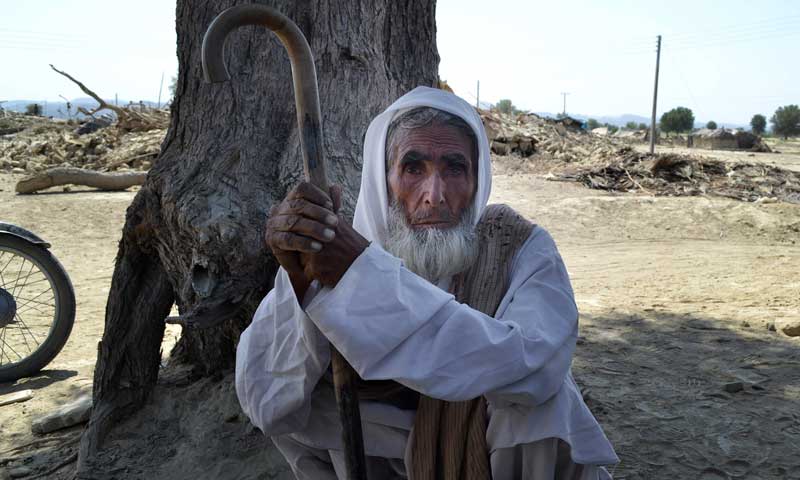
KHUZDAR: The death toll from a massive earthquake that jolted southwest Pakistan rose to 356 on Thursday, with officials saying that thousands have been left homeless and about 300,000 people had been affected in remote parts of Balochistan province.
The 7.7-magnitude quake struck Tuesday afternoon in the province, toppling thousands of mud-built homes as it spread havoc through Awaran and Kech districts and the southwestern parts of the country.
At least 356 people have been confirmed dead and 619 others wounded, according to Balochistan government spokesperson Mohammad Jan Buledi.
Buledi told Dawn.com that six more bodies of earthquake victims were retrieved from Awaran district of Balochistan on Thursday.
He added that communications systems in the sparsely populated province were badly affected as a result of the earthquake and that rescue workers were facing difficulties in reaching survivors in remote areas of the province.
"I fear there may be more bodies buried under the rubble," Buledi further said.
However, the National Disaster Management Authority (NDMA) said it would use its own available resources for the rescue and relief, despite offers for help by the United Nations agencies, international donors and some countries.
“We have enough resources to cope with the situation that has emerged after the earthquake in Awaran and Kech, although international donors and some friendly countries have also offered their cooperation,” NDMA Chairman Maj Gen Mohammad Saeed Aleem said.
He said the NDMA’s relief goods stock in Karachi had been transported to the two districts and was being distributed among the affected people through the army, Frontier Corps and local administration.
Pakistan’s military on Wednesday rushed to reach the scene of the earthquake to launch a relief operation in the affected areas.

“A total of six districts, Awaran, Kech, Gwadar, Panjgur, Chaghi and Khuzdar, and a population of over 300,000 have been affected by the earthquake,” Buledi earlier told a press conference.
The provincial spokesman said aid workers were facing difficulties in reaching out to survivors since the communication system was severely affected by the earthquake. He said teams were working to recover bodies, but the priority was to move the injured to hospitals as soon as possible, a difficult task in a desolate area with minimal infrastructure.
“We are seriously lacking medical facilities and there is no space to treat injured people in the local hospitals,” he said. “We are trying to shift seriously injured people to Karachi through helicopters and others to the neighbouring districts.”

“There is nothing, patients are dying,” Rehmatullah Muhammad Hassani, an earthquake survivor told Dawn.com via phone from the District Headquarter Hospital in Awaran.
He said the patients were facing difficulties in getting basic first aid treatment in the hospital. “There are no doctors and paramedics,” Hassani said.
Hassani said that a large number of mud-walled houses had collapsed as result of the powerful earthquake tremors. “We fear there are people still trapped under the rubble,” he said. The Awaran resident added that authorities had yet to launch an effective rescue operation to retrieve the people stuck from under the rubble.
Nazar Muhammad, a paramedic, said 70 injured had been brought to district hospital Awaran for medical treatment. He said: “We have no surgery equipment and we are only providing basic first aid to the survivors.”
The army has sent 100 personnel as medical staff and 1,000 troops to the area to help with rescue efforts and has established a medical centre in Tarteej, one of the worst-affected villages.
The scale of the affected territory is daunting. Awaran's population is scattered over an area of more than 21,000 square kilometres. More than 60,000 people live within 50 kilometres of the epicentre, according to the UN disaster agency, mostly in easily collapsible mud homes.
Television footage showed collapsed houses, caved-in roofs and people sitting in the open air outside their homes, the rubble of mud and bricks scattered around them.
Abdul Rasheed Baloch, a senior official in the district, said teams had worked through the night to try to retrieve bodies and survivors from the rubble. “Around 90 per cent of houses in the district have been destroyed. Almost all the mud houses have collapsed,” he said.
Some of the dead have already been laid to rest in their villages, he said.

The US Geological Survey issued a red alert on Tuesday, warning that heavy casualties were likely based on past data, and the provincial government declared an emergency in Awaran.
Tremors were felt on Tuesday as far away as New Delhi and Dubai in the Gulf, while people in the Indian city of Ahmedabad near the border with Pakistan ran out into the streets in panic.
Office workers in Pakistan’s largest city Karachi rushed out of their buildings in an experience reminiscent of the 2005 earthquake to that hit the country.
A 7.6 magnitude quake in 2005, centred in Kashmir, had killed at least 73,000 people and left several million homeless in one of the worst natural disasters to hit Pakistan.
Iran’s Red Crescent reported no damage from the latest quake over the border from Pakistan.

Readers from the affected areas who wish to share their experiences through texts, photos and/or videos, can get in touch with us on talktous@dawn.com.









































